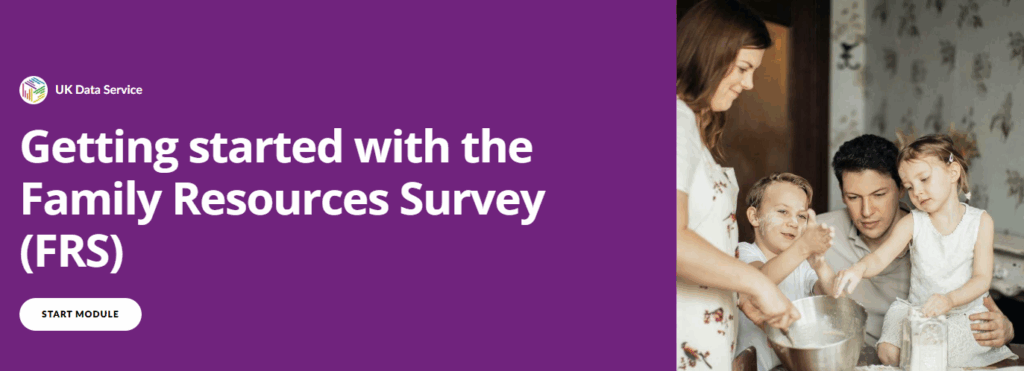 Rihab Dahab introduces us to the new Family Resources Survey interactive data skills module.
Rihab Dahab introduces us to the new Family Resources Survey interactive data skills module.
Last year (in March 2024), we published our online data skills module Introduction to the British Social Attitudes survey (BSA) as part of our continuing series on frequently used surveys, which are created in collaboration with the data producers.
We recently released our newest module Getting started with the Family Resources Survey (FRS), and we are excited!
The new module is a valuable resource for learning the fundamental concepts of the FRS, and the social surveys more broadly.
Building on the approach used in our BSA data skills module, the FRS module covers essential topics such as survey design, questionnaires, weighting, the use of documentation (and more!), making the survey easier to use and demonstrating how to access the UK’s primary data on income and living standards.
One of my favourite sections in the module is “Datasets Related to the FRS”, which does a great job of breaking the information down clearly and accessibly.
The section highlights three key datasets and statistics derived from the FRS, with a brief description and guidance on where to access them, and overview of their key features.
If you’ve ever been unsure about the differences between the datasets or publications produced from the FRS or where to find them (I’ll admit, I found this a bit tricky at first!), this section is definitely worth checking out!
Want to access the Family Resources Survey data?
The UK Data Service provides access to a wide range of FRS datasets. Depending on what you need, there are different levels of access. Some data are available under standard conditions, while others (like Secure Access data) require a more detailed application process.
Don’t worry though, there are plenty of guidance and support to help you through it. Wondering where to start? Simply head to the FRS module to find out more.
Intimidated by the Family Resources Survey documentation?
The FRS is supported by comprehensive documentation that is available from various sources.
- The Department for Work and Pensions (DWP) – which funds the survey – provides methodological details, user guides, departmental publications, and annual technical reports.
- We at the UK Data Service provide access to datasets and detailed documentation, including metadata, questionnaires, and codebooks.
Yet, some users get intimidated when they first start working with the survey.
That said, we can comfortably say that once you are familiar with the main documents, everything becomes more straightforward and easier to follow.
In the video below (also available in the module), Dr. Jennifer Buckley (Research Fellow) gives an overview of the useful documents available for finding information about the FRS variables.
Curious to explore the Family Resources Survey data yourself?
The module is supplemented by hands-on exercises using the Family Resources Survey, 2022-2023. These are designed to introduce the FRS datasets, build confidence with syntax-based software (R and SPSS), and carry out exploratory analysis.
With guided instructions, ready-to-use code, and questions to check understanding (don’t worry, answers are provided too!), the exercises provide a practical way to learn right on your own device.
What makes the Family Resources Survey module work?
This new interactive module is designed for self-learners who are new to the FRS, providing a guided introduction to the survey in under two hours.
It is flexible too, so there is no need to complete all the sections in one go, and users can revisit them whenever it suits their schedule.
Plus, to enhance the experience, we created media-rich content using Rise 360. We used many of its features to make the module fun and engaging. We also took great care to ensure the module is as accessible as possible, so everyone can use it without barriers.
And we were pleased to team up with DWP’s FRS team to produce some of the materials. Anna Britton (Higher Statistical Officer) made a valuable contribution by creating several of the videos included in the module.
What the Department for Work and Pensions team said about the module
FRS datasets have been available to users through the UK Data Service for many years. We’re pleased to have collaborated with the UK Data Service on developing new training for users.
This module will be hugely beneficial to anyone interested in the incomes and characteristics of UK families. It will help new users get started with their analysis and provide valuable support for analysts at all levels.
Steve Ellerd-Elliott – Chief Statistician, Department for Work and Pensions
More Family Resources Survey materials from the UK Data Service
The FRS data include a wide range of topics that are key to researchers and analysts across disciplines in both the public and private sectors. They are used in academic research, student projects and applied work in non-academic sectors. The full set of FRS data is available from the UK Data Service.
We also invite our users every year to share their research at the Family Finance Surveys User Conference, showcasing work based on family finance-related surveys.
The conference features presentations using several surveys available from the UK Data Service, a main one is the FRS. It is free to attend and organised by the UK Data Service in collaboration with the DWP and the ONS. The event offers a great opportunity for researchers to present their work, connect with data producers, and engage with fellow researchers.
Furthermore, our dedicated helpdesk team is always here to offer guidance and support for research and projects that use the FRS or other data and resources available through the service.
Finally, why the Family Resources Survey?
The FRS stands out among surveys as it is particularly focused on household income, benefits, and living conditions in the UK.
It provides extensive data on income sources such as earnings, state benefits, tax credits and pensions. Also, it captures information on housing costs, savings and material deprivation to assess financial wellbeing.
In addition, the FRS links income data with demographics, including household composition, disability status, and childcare, which provides broad understanding of financial circumstances across different population groups.
Moreover, the FRS is a key source for creating other datasets and government reports, including Households Below Average Income (HBAI), the Pensioners’ Income, and the Income-Related Benefits: Estimates of Take-Up.
The DWP uses them to assess how budgeting decisions, taxation and changes to benefits impact people’s daily lives.
Government departments also rely on the survey’s findings to evaluate the effect of existing policies on different community groups and inform future policy decisions.
That’s just a glimpse of why we recommend the FRS, and now it’s even easier to learn!
About the author
Rihab Dahab is a Research Associate at the University of Manchester and a member of the User Training and Support team for the UK Data Service (The Cathie Marsh Institute for Social Research).
Rihab develops resources to support researchers and data users from non-academic sectors. Her research focuses on the impact of armed conflict on children undernourishment and using multilevel modelling to address research questions.
Comment or question about this blog post?
Please email us!

